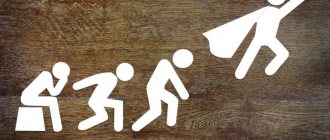The concept of consciousness and self-awareness. The structure of consciousness and self-awareness.
The concept of consciousness and self-awareness. The structure of consciousness and self-awareness.
Consciousness is the highest, human-specific form of generalized reflection of the objective stable properties and patterns of the surrounding world, the formation of a person’s internal model of the external world, as a result of which knowledge and transformation of the surrounding reality is achieved. The following properties of consciousness are distinguished: building relationships, cognition and experience . Consequently, thinking and emotions are included in the processes of consciousness (In consciousness, an image and thought can, colored by emotions, become an experience). Consciousness develops in a person only through communication and work, i.e. only in the conditions of the existence of language, speech, which arises simultaneously with consciousness in the process of labor. Functions of consciousness : reflective, creative-creative, regulatory-evaluative, reflective function (main function).
The structure of consciousness is a certain system of levels and projections that describe the nature of the reflection of reality. Structure: cognitive component – formed on the basis of a person’s total knowledge about the world. It includes cognitive mental processes that provide cognition. The affective component - a person not only learns about the world, but also has his own attitude towards it, which he is able to understand with the help of emotions and feelings. Regulatory component - a person is able to regulate his behavior and give himself a response to this. This regulation can be arbitrary or volitional.
If these components are absent, then the action is performed without conscious control. And if these components are turned towards themselves, self-consciousness arises (consciousness, the object of which is the person himself, i.e. this is a person’s idea of himself and the world around him). Therefore, self-awareness is purely individual.
Self-awareness is a dynamic, historically developing formation that appears at different levels and in different forms.
Levels of consciousness : sensory-emotional , associated with the direct reflection of external reality (sensation, perception, idea); rational-discursive (implying intellectual processing of sensory data in accordance with a given cultural tradition, logic and values, intuitive-volitional , awareness . “Self-awareness is born not as a result of the internal needs of an isolated consciousness, but in the process of collective practical activity and interpersonal relationships. 1. Self-observation In myself I notice events that represent my own modes of perception, memory, feeling, etc. I pay attention to various kinds of fleeting, almost imperceptible phenomena. Between me and what I observe in myself as some external object , a certain distance is established, and I am fully aware of this. My attitude is neutral - as in all those cases when I have to deal with data.
2. Understanding oneself (“self-understanding”). I attribute what happens in me to certain motives and connections; I'm trying to clarify them. As long as this inner contemplation does not go beyond mere observation, it can point to countless different possibilities. But understanding interpretation is also infinite and always relative. Ultimately, I never know what exactly I am, what motivates me, what motives are truly decisive. In myself I can recognize a wide range of different possibilities - sometimes hidden ones. Understanding yourself is not just a desire to know; otherwise it would be groundless.
3. Self-clarification - Passive self-understanding provides the environment necessary for actual self-clarification. The latter occurs due to full participation in activity, which in philosophical terms is designated as a form of internal behavior, as the unconditionality of a decision; in psychology, such activity cannot be accurately recorded, while crises of self-understanding with all their dark sides and inversions have been quite well studied psychologically. When it comes to demonstrating the processes of self-clarification using conceptual constructs from the field of psychological understanding, here Kierkegaard is still an unsurpassed master. Let us point out several points of interest from a psychopathological point of view.
Sensation as the basis of cognition, types of sensations.
Sensations are a reflection of certain properties, qualities, aspects of objects and phenomena of material reality that affect the senses at a given moment . Sensing, perceiving, visually imagining any object, any phenomenon, a person must somehow analyze, generalize, in other words, think about it . For sensations to arise, an external stimulus is necessary (affecting the senses and phenomena of the world). By means of sensations, a person learns about such properties as smell, taste, hardness, softness, sound, light. Thanks to sensations, we can determine the movement and position of our body in space. The senses are the only channels through which the external world penetrates into the human consciousness. Those. they receive, select, accumulate information and transmit it to the brain. And thanks to the brain, an adequate reflection of the world and the state of the body appears.
Sensations have properties: Intensity - determined by the strength of the stimulus and the state of the organ that perceives the stimulus. Duration is the duration of action of the stimulus. Spatial localization - remote receptors give us information about the location of the source in space, etc.
Types of sensations: Extroreceptors (located on the surface of the body and recognize the properties of objects and phenomena of the external environment) are divided into contact (tactile, taste) and distant (vision, hearing, smell). Introceptors - hunger, nausea. Proclioreceptors are located in internal organs and reflect their condition. They are located in muscles and ligaments and provide information about the movement and position of the body. There are also separate types: vibration, temperature, equilibrium.
Sensation has its own laws: sensitivity thresholds, sensory adaptation, interaction of sensations. The sensitivity threshold is divided into a lower threshold (the lowest strength of the stimulus at which barely noticeable sensations first appear) and an upper threshold (the highest strength at which the stimulus is still felt. If the stimulus exceeds this value, then pain occurs). Speaking of sensory i.e. changes in sensitivity under the influence of constant exposure to a stimulus are divided into 3 types: adaptation and complete disappearance of sensation , adaptation as a decrease in sensitivity under the influence of a strong stimulus, adaptation as an increase in sensitivity under the influence of a weak stimulus.
The concept of attention, its properties and types.
The most important feature of the course of mental processes is their selective, directed nature. — as attention is the focus of the psyche (consciousness) on certain objects that have a certain significance for a person, the concentration of consciousness, suggesting an increased level of intellectual or motor activity.
They distinguish between visual and auditory sensory attention. The objects of intellectual attention as its highest form are memories and thoughts. Sensory attention has been the most studied.
There are three types of attention: involuntary, voluntary and post-voluntary.
Voluntary attention is a consciously regulated concentration on an object. A person focuses not on what is interesting or pleasant for him, but on what he should do. This type of attention is closely related to will, because. a person makes a volitional effort.
Properties of attention:
Volume, Concentration, Distribution of attention is expressed in the ability to simultaneously perform several actions or observe several processes and objects. In some professions, the distribution of attention becomes especially important. stability refers to the general focus of attention in the process of activity. -interest. distractibility. The physiological explanation for distractibility is either external inhibition caused by extraneous stimuli or prolonged exposure to the same stimulus. Fluctuations Switching attention
A distinction is made between voluntary and involuntary switching of attention . Voluntary switching of attention occurs when there is a change in activity, when new tasks are set, etc. Involuntary switching of attention is accompanied by the participation of a person’s volitional efforts. Involuntary switching of attention usually occurs easily, without much tension or volitional effort.
Character and its structure.
Character is a set of personality traits that determine a person’s attitude towards people, towards ongoing events, and his actions, called deeds. H. is a holistic formation of a personality that determines the characteristics of a person’s activity and behavior and is distinguished by a stable attitude towards various aspects of activity. It combines the result of the interaction of both natural factors and life circumstances. Physiol. the basis of the character: the type of nervous system, a system of temporary connections that arise under the influence of external influences. Character traits include : responsiveness, frankness, demandingness, hard work, honesty, distrust, secrecy, boastfulness, cunning, etc.
Character traits are divided into 3 groups: strong-willed, business and communicative . Will is the sacred state of a person, cat. manifests itself in the ability to consciously control one’s psyche and actions . A person’s character is, to a certain extent, not always a conscious worldview that has become human nature.
Business traits are those traits that manifest themselves in work.
Communicative - which are manifested in communication.
There is also a division of the chela’s character traits into motivational (encourage, guide and support - for example, determination) and instrumental (give style - for example, theatricality, modesty, restraint)
Accentuation of character is a concept that means the excessive expression of individual features of character and their combinations.
Har-r is not a frozen formation, but is formed and transformed throughout a person’s life path.
Stages of development:
1. Infancy (0-1), oral sensory, trust or distrust in the world arises. The child seems to absorb the image of the mother.
2.Early childhood (1-3) muscular-anal, begins to walk, assert independence. But a sense of independence should not undermine trust in the mother. Parental demands for restrictions create the basis for feelings of shame and doubt.
3.Childhood (3-6) Added to independence. initiative, actively explores the world around him. Conscience and moral responsibility are laid down. Excessive disapproval causes a feeling of guilt, fear of punishment. Initiative is inhibited, passivity develops. Gender identification occurs, the child learns a certain form (male or female)
4.school age (6-12) precedes the child’s puberty. Developed latent stage (cultivation of hard work, necessary mastery of new knowledge) Together with a sense of competence, developed. feeling of inferiority. Period of professional identification.
5.Adolescence and adolescence are the period of the deepest crisis. When completed, the stage leads to the formation of identity. Main The task is self-determination of the choice of life path. When you can't find your place, watch. diffuse identity.
6.Early Maturity ( 20-25) problem of closeness (intimacy). True sexuality emerges. The time to start a family brings love.
7. Maturity or Middle age (26-65) A person’s attitude towards the products of his labor and his offspring, concern for the future of humanity becomes decisive. The desire to be productive, to realize one’s ability to pass something on to the next generation. If productivity is not achieved, if there is no need to care for others, indifference and self-focus appear. 8. Late maturity becomes integrative: the fruits of the seven previous stages ripen.
3. Brief description of A. Bandura’s theory of social learning. The theory of staged development of the psyche by J. Piaget.
Albert Bandura's theory purports to explain the ways in which people acquire a variety of complex behaviors in their social environments. Bandura talks about the existence of a mutual relationship between behavior, subjective and environmental variables. We are not driven only by internal forces, we are influenced, but we also influence our environment. Learning in humans is largely determined by processes of modeling, observation, and imitation . He formulates the thesis that changes in behavior caused by classical and instrumental conditioning, as well as extinction and punishment, are actively mediated by cognitions. The processes of self-regulation and self-control also play an important role in human behavior.
In research Piaget shows the qualitative originality of children's thinking, special children's logic. A child, like an adult, has a definition. action patterns that allow him to solve a variety of cognitive tasks. Child, when decided problems use 2 mechanisms: assimilation and accommodation . Assimilation is the inclusion of a new problem situation into those that the child can cope with without changing existing patterns of action. Accommodation - action patterns are changed so that they can be applied to a new task. In the process of ass. and acc. unite - adaptation.
Periods:
1. Sensorimotor (0-2) Speech is not developed. There are no ideas, behavior is based on the coordination of perception and movement. Once born, the child has innate reflexes. After the exercise he cajoles them.
2. representative intelligence ( thinking with the help of ideas) and specific operations. About 2 years of forms. Action plan. A strong figurative beginning with insufficient development of verbal thinking leads to a kind of logic.
-The stage of pre-operational ideas, the child is not capable of evidence or reasoning. Focuses on the external signs of objects. Egocentrism - views the whole world from its own point of view.
-The stage of concrete operations is associated with the ability to reason, prove, and correlate different points of view.
-3. The period of formal operations acquires the ability to think like an adult, considers judgments as hypotheses, thinking becomes hypothetic-deductive.
4. The concept of leading activity and its qualitative characteristics.
Leading Activity is an activity, the implementation of which determines the formation of the basic psychological formations of a person at a given stage of development of his personality. Within V. the preparation, emergence, and differentiation of other types of activities take place. The essence of the concept can be formulated in the form of the law (principle) of mental development, which asserts the existence of a correspondence between the stage of mental development and a certain type of mental development. The significance of mental development for mental development depends, first of all, on its content, on what sides of reality a person discovers and assimilates in the process of its implementation. . types of V. d .: 1) direct communication of the baby with adults; 2) object-manipulative activity, characteristic of early childhood; in the process of performing it, the child learns historically established ways of acting with certain objects; 3) role-playing game, typical for preschool age; 4) educational activities of younger schoolchildren. At each stage of childhood, V. does not appear immediately in a developed form, but goes through a certain path of formation. Its formation occurs under the guidance of adults in the process of training and education. In turn, the emergence of a new V. does not mean the abolition of the one that was leading at the previous stage. This or that period of mental development is characterized by a unique system of various types of activities, but in this complex system V.D. occupies a special place, determining the occurrence of major changes in mental development at each individual stage.
Leading activity is that activity of the child within the framework of the social situation of development, the implementation of which determines the emergence and formation of his main psychological new formations at a given stage of development.
Each stage of a child’s mental development (each new social situation of development) is characterized by a corresponding type of leading activity. A sign of transition from one stage to another is a change in the leading type of activity. VD structure:
persisting (the one that was);
— the VD itself;
— nascent (one that will appear in subsequent stages).
Each type of leading activity generates its own effects in the form of new mental structures, qualities and properties.
Specifics of a child’s objective activity at an early age.
At this age, the lines of mental development of boys and girls separate. They have different types of leading activities. In boys, on the basis of object-based activity, object-tool skills are formed. In girls, based on speech activity - communicative.
Object-tool activity includes manipulation with human objects, the rudiments of design, as a result of which abstract, abstract thinking is better developed in men.
Communicative activity involves mastering the logic of human relationships. Most women have more developed social thinking than men, the sphere of manifestation of which is communication between people. Women have finer intuition, tact, and are more prone to empathy.
Gender differences in the behavior of children are due not so much to biological and physiological reasons as to the nature of their social communication. The orientation of boys and girls to different types of activities is socially determined, due to cultural patterns. In fact, there are more similarities than differences between male and female babies. The differences appear later. Basically, boys and girls develop in parallel and go through the same stages.
Thus, by the age of three, children of both sexes develop the following new age developments: the beginnings of self-awareness, development of self-concept, self-esteem. The child does 90% of the work of acquiring language. In three years a person passes half the way of his mental development
5. Concept and main directions of human mental development/
Mental development is considered as a change in the human psyche during the process of ontogenesis (from birth to adulthood). A metaphysical approach to the problem of mental development involves considering it as quantitative changes in the psyche (attention, memory, experience, qualities). The dialectical approach involves considering mental development not only as quantitative changes, but primarily as the emergence of new forms and qualities of the psyche, i.e. qualitative changes. According to L.S. Vygotsky, mental development is quantitative accumulations that lead to the emergence of new qualitative indicators, to the emergence of mental neoplasms, those forms and qualities of the psyche that did not exist at the previous stage. The period of quantitative accumulations into qualitative new formations can be both fast and long-term (learning to speak, think, a habit appears).
The source of development is life itself and the changes that occur in it. The prerequisites for mental development are biological factors - heredity and innateness. The biological factor creates the basis for mental development. The conditions for mental development are social factors - the influence of the social environment: 1) life in human society; 2) macro environment (society); 3) micro-environment (family and d/s): 4) Natural environment; 5) the mental activity of the child himself in various types of activities: 6) purposeful training and education under the guidance of adults. Mental development as a holistic process includes the following leading lines of development - I) development of knowledge and methods of activity; 2) development of mechanisms for applying methods of activity and knowledge through the assimilation of methods of activity and knowledge through the assimilation of methods of mental activity; 3) development of the child’s personal qualities.
The main laws of a child’s mental development are : 1) mental development is carried out as a transition from external practical actions to internal mental ones (interiorization); 2) mental development is carried out in the process of active activity; 3) mental development is carried out under the guidance of an adult.
Infancy.
Infancy (2-12 months) is the first period of the era of early childhood. The leading activity is direct emotional communication with a close adult. The motivational-need sphere receives priority development. The central problem of age is the development of forms of communication with loved ones.
-4 months Actively reacts to what he sees and moves. Responsive to color. Developed Spatial perception. Hand movement directed towards an object, feeling the object. Recognizes familiar faces (smiles). Appeared different emotions comp. (surprise, anxiety, relaxation).
-Up to 6 months, emotions predominate. Communication, in the speech of an adult, the baby perceives only emotions. Coloring. Expresses his emotions in the form of movements, gestures, babble.
-After 6-8 months beginning. form. situational business communication (joint activity of a child and an adult). The need for communication arises under the influence of 2 conditions: the objective need for care and concern of others, the behavior of an adult, cat. addresses the child.
-5-6 months grabs an object (1 purposeful action)
-7 months “correlating actions”: putting small objects into large ones, opening, closing the lid.
-10 months - 1 functional. actions, but they are not yet objective (imitation of adults)
-7-11 months fear of separation
Year 1 crisis.
-Transitional period between infancy and childhood Surge of independence Autonomous speech Own logic, words become ambiguous and situational Walks, performs actions with objects Understands adults, their speech, need for communication Biological. Independence
Speech:
-Up to 6 months formation. speech hearing
-After 6 months babbling with gestures
-By the end of 1 year – understands 10-20 words, pronounces 1 or several words himself.
Needs:
-In play activities, but with a different content. Need for movement. Cannot sit quietly for a long time in lessons. In external impressions. Accurately fulfill the teacher's requirements. Master new skills. Knowledge Get good grades Be the best student Perform a social role (prefect)
Self-esteem. 3 groups:
1. They focus more on knowledge about themselves than on the assessment of adults. Represented About yourself adequately. 2. Represented about themselves are relatively inadequate and unstable. They do not know how to analyze their actions. 3. Ideas about oneself are unstable and inadequate. Ignorance of oneself leads to the inability to focus in practical activities on one’s objective capabilities.
Self-esteem:
1.adequate. Select tasks according to their capabilities.
2.high adequate. maximum independence and self-confidence. Correct assessment of your capabilities.
3. Overpriced. overestimation of capabilities, arrogance, snobbery, tactlessness.
4.inadequately understated. Only easy tasks. The activities of others are overestimated. They tend to withdraw into themselves. Vulnerable.
In the process of education, reinforcement, encouragement, and punishment play a huge role.
14.Adolescents.psych.development, Ved. activity. Causes of conflicts.age.psycho
11-15 years old. Considered difficult, critical, reasons:
1. differences between the demands made by society on children and adults, differences in their responsibilities and rights. 2. fast pace of physical events. and mental changes in a teenager. 3. accumulation of upbringing defects. 4. psychological changes that occur during puberty, changes in self-perception. 5. awareness of the differences in their positions in the family. Theoretical reflective thinking continues to develop Reflexive nature of thinking: analyze the operations that are carried out, methods of solving problems. Further intellectualization of perception and memory takes place.
Development
of imagination. The convergence of imagination with theoretical thinking gives impetus to creativity. The imagination is less productive than that of an adult, but it is richer than the imagination of a child. Relationship with adults . The influence of parents is limited, but value orientations are completely dependent on them. The main difficulties arise due to parental control over the behavior and studies of a teenager. Difficulties arise when parents have high expectations that the teenager is unable to meet. Conflicts arise when parents treat him as a small child. Relationships with others are the most important aspect of a teenager's life. If the need for communication is not satisfied, difficult experiences appear. Ved. type of activity - communication activity.
15.Teenagers. neoplasm. Basic areas of personality. age crazy
A new formation appears - a feeling of maturity. , which is a core feature of a teenager’s personality. Sources of the feeling of adulthood: -Consciousness of shifts in the physical. Development - Social change Provisions - Changes in the attitude of adults towards him - Puberty.
A teenager strives to resemble an adult in appearance.
Makes demands to communicate with him as with an adult. The formation of personality is determined by the need for self-affirmation. Forms of self-affirmation: Pugnacity, Stubbornness, Willfulness, Negativism
There is a focus on knowing and assessing the moral and psychological qualities of others. Self-awareness begins to form and develop , the need for awareness and assessment of one’s personal qualities. Self-awareness is objective and figurative.
He sees himself among others as he thinks others perceive him.
Self-esteem. They begin to evaluate others earlier than themselves; they are able to evaluate others better and more correctly. Emotions and feelings are more powerful and difficult for adults to control.
Passionate, hot-tempered, poorly restrained. 16.Early youth. age crazy
Specifics of communication with adults: the growing democratization of intergenerational relationships, solving the problem of autonomy of grown children - behavioral, emotional, moral and value autonomy. At this age, there is an increase in the need to communicate with peers, and the development of the ability to establish more selective, friendly relationships. Gender characteristics are manifested in youthful friendship: Strong youthful friendship: In early adolescence, the need for solitude appears. Professional self-determination and the construction of life plans for the future are the central psychological new formations of adolescence. The new personality is the formation of personal identity. According to E. Erikson, an identity crisis includes a number of oppositions: time perspective or a vague sense of time, self-confidence or shyness. In the case of a negative resolution, role confusion occurs: the young man is unable to complete psychosocial self-determination for a more or less long time, which forces him to return to an earlier stage of development. In this case, specific difficulties may arise:
- diffusion of time - stagnation in work - negative identity Self-awareness in early youth acquires integrity. A feature of self-esteem is a clear identification of the area of achieving results. Quite often one encounters an overestimation of one’s own capabilities, “youthful self-confidence.”
the emergence of a desire for self-education. Youth is a decisive stage in the formation of a worldview. The emotional sphere develops in youth. New personality formations: professional self-determination; making life plans; formation of personal identity; sustainable self-awareness; presence of self-esteem; need for self-education; formation of worldview.
1.. Subject, tasks, structure, methods of teaching. P. Interdisciplinary connections ped.psych.
Ped. Psycho-me –
area of knowledge between psych. and ped-coy.
Item
: numbers of mastering knowledge, skills, abilities, their use, development of the student and his creative abilities.
Tasks
: reveal the mechanism of influence of training and education on the development of the student; determination of the connection between the level of intellect. and personal student development and forms of teaching and educational influence; study of psychology the fundamentals of a teacher’s activity; development of psychol. basics further. improving images. process.
Methods
: Method is those techniques and means by which you can obtain data about the object under study.
1) Basic (observation - studying the object of education without intervention, experiment - active intervention of the researcher in the activity of the subject), Auxiliary (survey - responses of the subjects to specific questions, testing, analysis of the results of the activity)
Structure
: 1) P. training 2) P. education 3) P. teacher
Interdisciplinary. communications
: science formed. at the intersection of psychology and pedagogy; she is closely connected. with developmental pedagogy and psychology; last connection with general psychology, as well as with other sciences.
2. Human training and development. Correlation of teaching with learning and teaching.ped.psych.
Development
- this is an objective process of internal, consistent quantitative and qualitative changes in the physical and spiritual powers of a person.
Education
– management of educational activities of the younger generation, in the process of cat. knowledge, skills, abilities are acquired, individual-psychology is formed. saints of personality and abilities
1) Any training is developmental. Each step of learning was also considered a step of development.
2) Development creates opportunities, training realizes them.
3) The process of child development does not coincide with the learning process, but follows it.
It is the zone of proximal development that learning should create. Then learning will promote development, relying not only on mature, but also on maturing mental functions.
Learning -
the process and result of acquiring individual life experience.
Learning differs from teaching as the acquisition of experience in activities guided by cognitive motives and goals. Learning includes unconscious processes of understanding the content of the material and consolidating it.
Education
– management of educational activities of the younger generation, in the process of cat. knowledge, skills, abilities are acquired, individual-psychology is formed. Saints of personality and ability.
Teaching
– consciousness, act. process, organization one subject, direction on the act. mastering a system of knowledge, skills and abilities.
Teaching is a specially organized cognitive activity (as opposed to learning).
Learning as a process includes two parts: teaching, during which a system of knowledge, skills, and experience is transferred, and learning as the assimilation of experience through perception, comprehension, transformation and use.
3. (General characteristics) Psychological characteristics of educational degree
Learning is an active, conscious process organized by the subject himself, aimed at the active assimilation of a system of knowledge, skills and abilities (KUN). Educational activity (EA) is social, there is objectivity, awareness, purposefulness. UD is an activity aimed at a person acquiring new knowledge or changing them in the process of specially organized and targeted action. The content of UD is related to what it is aimed at - the subject - assimilation of knowledge, mastery of generalized abilities and changes in the subject of UD.
Psychological characteristics of UD:
1.specially aimed at mastering educational material and solving educational problems. Tasks
2. mastering general abilities of action and educational concepts
3. leads to a change in the subject himself
4. changes occur in the psychological properties and behavior of the student depending on the results of his actions
UD structure:
1.motivation – a set of motives that encourage a student to master the learning system and determine the intensity of learning activities
2.learning task is a method of action or knowledge that a student must master under certain conditions
3.educational action - determined by the motivation of the educational process, subordinate to the educational goal and including a set of operations performed by the student to solve the educational problem
4.control and evaluation
The concept of consciousness in ancient philosophy as an ideal substance
Consciousness is one of the central categories of philosophy, through which the central philosophical problem of comparing consciousness and being, ideal and material is formulated.
The category of consciousness has been developed in philosophy since ancient times. In ancient and medieval philosophy, instead of the word consciousness, the term soul or spirit was used.
The most detailed concepts of the soul were developed by such philosophers as:
Help with student work on the topic of Consciousness and self-awareness. Consciousness and the problem of the ideal
Coursework 450 ₽ Essay 260 ₽ Test paper 250 ₽
Get completed work or consultation with a specialist on your educational project Find out the cost
- Plato,
- Aristotle,
- Democritus
In Plato's idealistic theory, the human soul was understood as an idea - an ideal and abstract essence, eternal and indestructible, which exists beyond the boundaries of physical reality and is immaterial in nature. The totality of ideas makes up the world of ideas, which, according to Plato, is true reality, real being, while the physical world is nothing more than its rough and inaccurate copy. In this way, the soul was taken beyond the existence of an individual person; it acquired a much more perfect, substantial nature, becoming one of the root causes of the existence of the world.
The materialistic idea of the soul in antiquity was developed by Democritus. The philosopher believed that the soul consists of special atoms - the lightest and most mobile, which, being in the bodies of creatures, impart vital properties to them. Democritus associated death with the excessive outflow of particles of the soul from the body, which made the soul - as a stable structure of spiritual atoms in a particular body - mortal, but the atoms themselves have substantiality - eternity, indestructibility and independence from the world, which makes the spirit itself immortal in nature.
Do you need proofreading or review of academic work? Ask a question to the teacher and get an answer in 15 minutes! Ask a Question
The synthesis of these views can be noted in Aristotle. Aristotle understands the soul as mental processes accessible to reflection - sensory perception, affects, needs, abstract thinking, as well as the reason for the growth and movement of living beings from plants to humans. At the same time, the soul consists of many parts that die along with the person, all except one - abstract thinking, which is ideal and forms part of the cosmic mind.
Basic Concepts
Consciousness is the highest function of the human brain.
It allows you to reflect the surrounding reality, interpret all current phenomena and events, plan upcoming actions and anticipate their results.
Consciousness helps you control your behavior and regulate your activities.
Its main components are: attention, memory, will, emotions and feelings.
Attention , the ability to perceive the environment and concentrate on individual objects. Attention helps a person in cognitive activity.
Memory is the ability to record learned images and reproduce them if necessary in the future.
The will directs all the actions and actions of the individual. It is a motivating force that forces you to act purposefully.
Emotions and feelings, the highest stages of development of consciousness, thanks to which it becomes possible to build interpersonal relationships and manifest internal sensations.
A special phenomenon from a psychological point of view is the ability to turn off consciousness .
Once the necessary skills and abilities are learned, they can be carried out automatically.
In this case, control over one’s behavior is no longer needed , since the body itself performs the usual actions that were practiced during the acquisition of the skill.
Thus, an experienced pianist does not think about the movements of his hands while playing, and an experienced driver does not analyze the manipulations he performs while driving.
Self-awareness is the highest level of consciousness, which reflects a person’s perception of himself as an individual. It forms ideas about one’s body, character, relationships with people, place in society, achievements, etc.
There are three main levels of self-awareness:
- First . Ideas about the body and its place in the surrounding space. At this level, there is an understanding that our body is a separate independent phenomenon, which to a certain extent is included in the existing order of things.
- Second . The attitude of oneself to a certain social group, community, social institution. At this level, the individual perceives himself through the prism of his social life.
- Third . The most complex and important level, which allows you to identify your own “I”. A person perceives himself as a full-fledged person with a set of qualities, emotions, feelings, and abilities. He fully understands his mental, emotional and intellectual needs and abilities. He is responsible for his own actions, desires and for his future.






